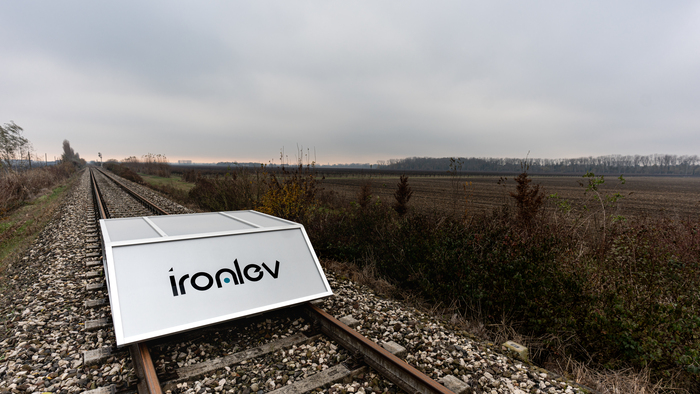Train noise is a major source of noise in Germany.
But more and more traffic should be on the rails.
Now it is recalculated how loud it really is along the tracks.
Karlsruhe (dpa) - "The ICEs are the worst," says Margit Rödder.
When the fast trains rush by in front of their house, the noise of the wind was especially annoying.
The daughters' rooms have windows facing the tracks.
"They don't open a window in summer."
When Rödder and her husband bought a house in Graben-Neudorf ten years ago, they also moved to the Karlsruhe-Mannheim railway line.
That was clear.
“The train was already there, we live with the train,” says Rödder.
But now the railway line is to be four lanes.
In order to transport more goods on rails between the regions and the sea ports of Rotterdam and Genoa, Deutsche Bahn is planning the expansion.
"The rail network between Mannheim and Karlsruhe is one of the most important rail connections in Europe," it says there.
The citizens' initiative Karlsruhe-Molzau, which Rödder co-founded, expects the number of freight trains to triple to 660 per day - that would be one every two minutes.
In addition to more fine dust and expropriations along the route, people also fear more noise.
According to the Federal Environment Agency (UBA), noise can lead to serious damage to health: hearing loss, tinnitus, high blood pressure, cardiovascular diseases are possible consequences, and blood lipid and blood sugar levels could be influenced.
The stress caused by noise also affects the nervous system.
According to the UBA, rail traffic is an “important source of noise” in Germany.
"Over a third of the German population feels disturbed or annoyed by rail traffic noise." According to this, around one million people are exposed to levels of more than 65 decibels all day long in German metropolitan areas along tracks and on railway lines with a traffic volume of at least 30,000 trains per year.
At night, over two million people are exposed to levels of more than 55 decibels.
That is how much a refrigerator can assume.
How loud it is along railway lines can be seen on noise maps from the Federal Railway Authority (EBA).
The companies Disy, Afry and Soundplan are currently working on the current overview, which should be published by summer 2022.
But the employees do not stand on the tracks with measuring devices.
"A selective measurement would only be a snapshot and with a view to the noise pollution would not be expedient at all," explains a spokeswoman for the Karlsruhe software company Disy Informationssyteme GmbH, which specializes in data management and geospatial analyzes.
Instead, the experts feed their computers with all kinds of data: Which trains go where and how many?
Is the area rather flat or can the sound spread in a valley between mountains?
Where are noise barriers located?
All of this is put together in calculations.
The data analysts are currently working on a prototype for an area in the Cologne metropolitan area.
If the EBA gives the green light, the algorithms can be applied to the nationwide route network.
For the first time, all routes of the federal railways beyond metropolitan areas and next to the main routes are mapped.
The figures make it clear that this is one of the largest geodata management projects in Germany: more than 33,000 kilometers of rails, around 25,000 bridges, 700 tunnels, around 14,000 level crossings, thousands of kilometers of noise barriers, a good 60 million buildings and tens of thousands of square kilometers of terrain models.
The pitfalls are often in the details, as the spokeswoman explains.
On the one hand, data would have to be simplified in order to minimize the computational effort.
For example, the Cologne Cathedral, with its many windows and decorations, should be included in the calculation as the simplest possible cuboid.
On the other hand, the results should be as accurate as possible in order to realistically represent the noise pollution for the environment.
Because further protective measures are planned on this basis.
The arithmetic operations are then a rather complex matter.
In addition to obvious factors such as the terrain, the professionals also have to consider many details such as train speeds and timetables.
And braking systems of different train types and the composition of trains also generate different noises.
For certain curves, a flat rate of eight decibels is added for “screeching noises”.
"Bridge roar" is also included - that is, noises caused by vibrations in a bridge when trains pass over it.
When it comes to modeling bridges, the data experts have to consider differences in the construction method anyway: for example, whether they are made of steel, concrete or masonry and what type of substructure they have.
“Of course, more traffic should be on the rails,” says Rödder from the Karlsruhe-Molzau citizens' initiative.
But she questions whether they have to lead through the communities.
“You can also think about a tunnel solution.” But that too would have to come from somewhere and require even more extensive construction work - with a corresponding noise.
© dpa-infocom, dpa: 210618-99-47620 / 3
Information about the project
Noise mapping at the EBA
Information about the Mannheim-Karlsruhe rail project
Information about Citizens' Initiative Karlsruhe-Molzau
Federal Environment Agency on rail traffic noise
Federal Environment Agency on the effects of noise
Noise viewer at the UBA












/cloudfront-eu-central-1.images.arcpublishing.com/prisa/KMEYMJKESBAZBE4MRBAM4TGHIQ.jpg)


